My own personal fad that became a trend – Hadban Enzahi crossed with Ansata Ibn Halima
– darling Simeon Sarah at 34 years old.
As you go through life sooner or later you will succumb to a fad, whether it’s the latest fashion, hairstyle or food. Being a clothes-aholic I’ve always been in love with vintage clothing. Is this a current fad or is it a current trend? So what’s the difference between a fad and a trend? It seems nothing in modern life escapes the influence of fads; fashion, food, music, exercise, books, slang words, movies, furniture, places to visit, even children’s names.
Wikipedia, en.wikipedia.org states that a fad is any form of behaviour that develops among a large population and is collectively followed with enthusiasm for some period. A fad is said to catch on when the number of people adopting it begins to increase rapidly. The behaviour will normally fade quickly once the perception of novelty is gone. Apart from the general novelty, fads may be driven by mass media programming, emotional excitement, peer pressure, or even a desire to be outside social norms.
Though the term trend may be used with fad, a fad is generally said to be a fleeting behaviour while a trend is considered to be a behaviour that evolves into a relatively permanent change.
In the 1950’s, the beatnik movement became a major fad that died out as its original advocates abandoned the movement. Though this fad was short-lived, it’s recognised for giving birth to the hippie movement in the following decade, and other inspiring social trends in the decades that followed.
According to Dr. Jack Santino, an expert in popular culture, people who follow fads are not irrational; they simply want to be part of something new and creative, and they feel special when they are part of an in-group. Dr. Santino points out that it’s sometimes difficult to see the difference between a fad and a trend. A fad, he says, lasts a very short time and is not terribly important. A social trend lasts a long time and becomes a true part of modern culture. A trend might be the use of personal computers; a fad might be certain types of computer games.
I began to think about some of the other fads and trends around me, and being associated with Arabian horses for many decades I’ve seen quite a few fads come and go. Some would be nice to see gone but sadly they are still with us.
The first fad that came vividly to mind is the Panda Eyes fad. I think this is more like a fashion-fad, where breeders/trainers make up the eyes of their Arabian horses with a usually shaved, big, black, shiny half-moon above the upper eye lid when presenting their horses for the show ring. I imagine this practice is to make the horse’s eye appear larger, though I doubt if it would fool many judges or anyone for that matter. And in saying this, it must appear attractive to the people who present their horses in this way, but when I look at these incredibly, beautiful horses presented in this way all I can see is an eyeless black hole. I’ll cross my fingers that it doesn’t become a trend.
No need for Panda Eyes simply lightly oiled black velvet skin – naturally beautiful.
Specific Arabian Bloodlines are also a fashion-fad. Whatever line is consistently winning in the show ring the sires producing these winners are used to the extreme.
I also observed many people who jumped on the straight Egyptian bandwagon hoping to boost their dwindling coffers. When straight Egyptian Arabian’s became the latest fashion-fad the breeders basically shot themselves in the foot by creating an oversupply. I don’t think I need to elaborate.
Over the years the show halters we use on our horses have changed with the current fashion so I would call this a fashion -fad. I have a wall with at least half a dozen different styles of show halters hanging on hooks in my back room. These show halters were all the rage at the time they were used. There’s rolled leather, flat leather, macramé, the old Lasma style and Egyptian styles to name a few.
Show halter in the late 198o’s
Now when I think of it, we’ve seen the fad of tails sweeping along the ground (I remember being guilty of showing horses with VERY long tails!) and bridle paths trimmed three quarters down an Arabian horse’s neck. And we must not forget our riding attire and how riding coats have changed over the years but this would be classed as a fashion-fad as well.
In the 1800?s and early 1900?s there was quite a fad for docking tails. You see them in older paintings and drawings of hunters, racehorses and carriage horses where the horses are portrayed with docked, or bobbed, tails. In docking the tail, the dock (the bony, muscular length of spine from which the tail hair grows) is cut through and removed, a painful and barbaric process for the horse and one which renders it unable to use the tail to swish flies from its body.
Docked tails depicted in this painting by Stubbs
A part of me has always wondered why most follow the leader?
Naturally this behaviour has a name; it’s called the BANDWAGON EFFECT.
The general rule is that conduct or beliefs spread among people, as fads and trends do, with the idea that any individual adopting the fad will become as popular and successful as the people who have already done so.
Again according to Wikipedia: The bandwagon effect is where the rate of uptake of beliefs, ideas, fads and trends increases the more that they have already been adopted by others. In other words, the bandwagon effect is where the probability of individual adoption increases with respect to the proportion that has already done so. As more people come to believe in something, others also hop on the bandwagon regardless of the underlying evidence.
In layman’s term the bandwagon effect refers to people doing certain things because other people are doing them, regardless of their own beliefs, which they may ignore or override. For instance, once a product becomes popular, more people tend to get on the bandwagon” and buy it, too. The bandwagon effect explains why there are fashion trends.
When individuals make rational choices based on the information they receive from others, economists have proposed that information cascades can quickly form in which people decide to ignore their personal information signals and follow the behaviour of others. Cascades explain why behaviour is fragile—people understand that they are based on very limited information. As a result, fads form easily but are also easily dislodged.
I don’t think there’s an answer to fads and certainly some of them are very enjoyable. I say this with my favourite Vintage clothing website minimised! Of course, there is a lot more I could say but I have no desire to preach. Most people actually know they should make responsible decisions regarding their lives. Certainly, I must mention that we should never forget the the positive trends often aided and applied by the spirited and hopeful young. There are some talented young people who do things differently but do they use their many skills and their imagination in away to help not hinder.
I often ask myself when I read Arabian magazines or on the rare occasion I have time to follow a conversation on Facebook or LinkedIn. What happens when the people, young or old accept the fads or trends and ignore the true desert phenotype of a living species like the Arabian horse and slowly continue to change the face of this ancient breed, what then?
Fads and Trends of 1987, Carmel holding filly foal Pearsons Sarchi (Simeon Shagrir imp x Simeon Sarah)
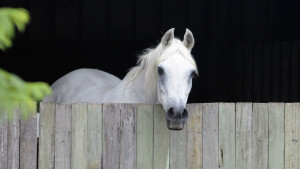
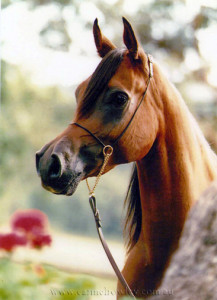
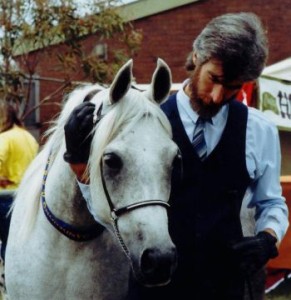
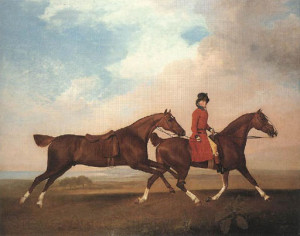
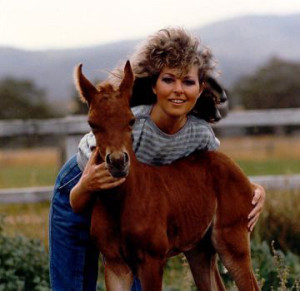
Leave a Reply